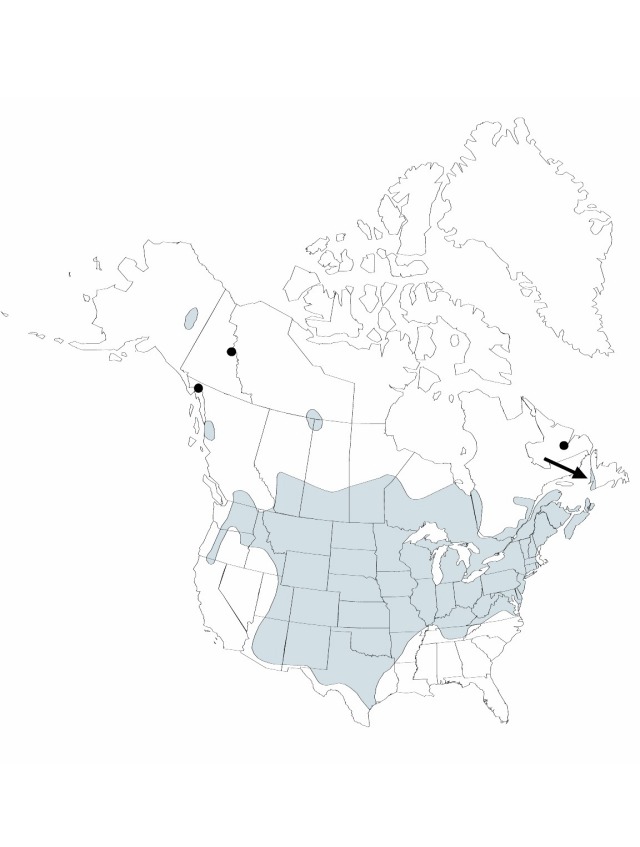Difference between revisions of "Juncus dudleyi"
Bulletin of the Torrey Botanical Club 27: 524. 1900.
FNA>Volume Importer |
imported>Volume Importer |
||
| (6 intermediate revisions by 2 users not shown) | |||
| Line 8: | Line 8: | ||
}} | }} | ||
|common_names=Dudley's rush | |common_names=Dudley's rush | ||
| + | |special_status={{Treatment/ID/Special_status | ||
| + | |code=F | ||
| + | |label=Illustrated | ||
| + | }} | ||
|basionyms= | |basionyms= | ||
|synonyms={{Treatment/ID/Synonym | |synonyms={{Treatment/ID/Synonym | ||
|name=Juncus tenuis var. dudleyi | |name=Juncus tenuis var. dudleyi | ||
|authority=(Wiegand) F. J. Hermann | |authority=(Wiegand) F. J. Hermann | ||
| − | }}{{Treatment/ID/Synonym | + | |rank=variety |
| + | }} {{Treatment/ID/Synonym | ||
|name=Juncus tenuis var. uniflorus | |name=Juncus tenuis var. uniflorus | ||
|authority=Farwell | |authority=Farwell | ||
| + | |rank=variety | ||
}} | }} | ||
|hierarchy=Juncaceae;Juncus;Juncus subg. Poiophylli;Juncus dudleyi | |hierarchy=Juncaceae;Juncus;Juncus subg. Poiophylli;Juncus dudleyi | ||
| Line 37: | Line 43: | ||
-->{{#Taxon: | -->{{#Taxon: | ||
name=Juncus dudleyi | name=Juncus dudleyi | ||
| − | |||
|authority=Wiegand | |authority=Wiegand | ||
|rank=species | |rank=species | ||
| Line 50: | Line 55: | ||
|publication title=Bulletin of the Torrey Botanical Club | |publication title=Bulletin of the Torrey Botanical Club | ||
|publication year=1900 | |publication year=1900 | ||
| − | |special status= | + | |special status=Illustrated |
| − | |source xml=https:// | + | |source xml=https://bitbucket.org/aafc-mbb/fna-data-curation/src/2e0870ddd59836b60bcf96646a41e87ea5a5943a/coarse_grained_fna_xml/V22/V22_359.xml |
|genus=Juncus | |genus=Juncus | ||
|subgenus=Juncus subg. Poiophylli | |subgenus=Juncus subg. Poiophylli | ||
Latest revision as of 20:30, 5 November 2020
Herbs, perennial, 2–10 dm. Rhizomes densely branching. Culms 1–20. Cataphylls 1–3. Leaves basal, 2–3; auricles yellowish, 0.2–0.4 mm, leathery; blade flat, 5–30 cm × 0.5–1 mm, margins entire, turned up, occasionally involute. Inflorescences compact and few flowered to loose and lax with to 80 flowers, 1.5–5(–9) cm; primary bract usually exceeding inflorescence. Flowers: bracteoles 2; tepals greenish, lanceolate, 4–5 mm; inner series nearly equal, spreading in fruit, nearly equal to or exceeding capsule; stamens 6, filaments 0.8–1.2 mm, anthers 0.6–1 mm; style 0.2 mm. Capsules tan, 1-locular to pseudo-3-locular, ellipsoid, 2.9–3.6 × 1.5–1.9 mm. Seeds tan to amber, ellipsoid to lunate, 0.4–0.67 mm, not tailed. 2n = ca. 84.
Phenology: Flowering and fruiting spring–early summer.
Habitat: Exposed or shaded sites in sandy to clayey soils, usually moist areas such as along stream banks, ditches, around springs
Distribution

Alta., B.C., Man., N.B., Nfld. and Labr., N.W.T., N.S., Ont., P.E.I., Que., Sask., Yukon, Alaska, Ariz., Ark., Calif., Colo., Conn., Del., D.C., Idaho, Ill., Ind., Iowa, Kans., Ky., La., Maine, Md., Mass., Mich., Minn., Miss., Mo., Mont., Nebr., Nev., N.H., N.J., N.Mex., N.Y., N.Dak., Ohio, Okla., Oreg., Pa., R.I., S.Dak., Tenn., Tex., Utah, Vt., Va., Wash., W.Va., Wis., Wyo., Mexico.
Discussion
Selected References
None.
